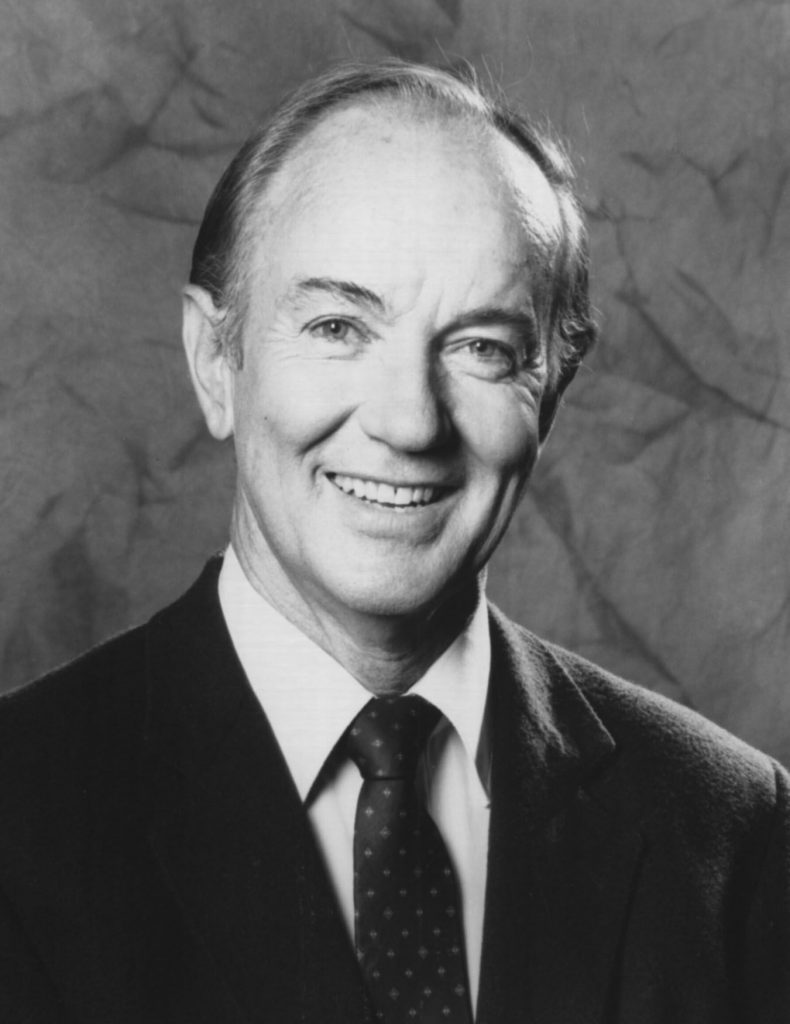Local broadcaster Stan Chambers,the 91-year-old native Angeleno, who attended St. Brendan School, Loyola High School and then-Loyola College (now Loyola Marymount University), died at his Holmby Hills home on Feb. 13.
The father of 11 children was never accused of a single on-air exaggeration or distortion during his 60-plus-year career. He explained his strict news ethics to former Tidings reporter and sports writer Rich Goul in March 1987. “I always hesitate before giving information that isn’t confirmed a couple of times,” he pointed out. “When you don’t know for certain, you just don’t use it. Rumors are difficult. I try to be as accurate as I can and check my sources before I go on [the air] with anything.
“The old guideline I have is ‘In doubt, don’t.’ The people want the facts, not your guesses.”
Chambers spent his whole broadcasting career, as a field reporter, news director and anchor, at KTLA-TV Channel 5 in Los Angeles.
After leaving Loyola College, he joined the U.S. Navy, who sent him to the University of Southern California to study international relations. He also spent a semester at USC working on a master’s degree in history. But then KTLA — the first commercially licensed TV station in the western United States — hired him in December 1947 as a production assistant. He built sets, ran errands and basically learned how this new media called “television” worked.
Soon he was doing some reporting and working on live variety shows. One of his early jobs was wearing ice skates to host a musical comedy on ice called “Frosty Frolics.” At the end of each show, he would take a scripted “spontaneous” flop onto the ice.
Two years after coming to KTLA, the 26-year-old Chambers covered a story that not only made TV news history but set him on a more than six-decade serious news broadcasting career. It happened at a vacant lot in San Marino. A 3-year-old named Kathy Fiscus had fallen down an abandoned well pipe during the night of April 8, 1949.
KTLA’s Bill Welsh and the cub reporter covered the rescue attempt for 27 1/2 straight hours, providing graphic details and running commentary. At one point, Chambers led viewers in an on-camera recitation of the Lord’s Prayer. When rescuers finally reached the toddler 90 feet down, she was dead.
“We were so wrapped up in the tragedy and reporting the story that we didn’t really have a chance to wonder if anyone was watching,” he told The Tidings. “We had no idea of the impact we were making.”
He would go on to carve out a special niche in on-the-scene reporting, including the Bel-Air/Brentwood Fire (1961), the Baldwin Hills dam disaster (1963), the Watts riots (1965), Sen. Robert F. Kennedy’s assassination (1968), the Sylmar earthquake (1971) and Olympics in Los Angeles (1984). In 1991, he broke the story of the beating of black driver Rodney King by four LAPD officers after a high-speed chase. And a year later, he covered the Los Angeles riots that flared up after those officers were acquitted of using excessive force.
Over the years, Chambers received repeated professional accolades, including many local Emmy and Golden Mike awards, for his objective news reporting. Viewers were often taken by his gentlemanly manner and believability.
“I had the Jesuit training, and there is no doubt it helps you in getting through very difficult situations,” said the longtime St. Brendon’s parishioner. “The faith gives you the base. It also is a continual drive that is there all the time that you can call upon. There are a lot of pressures in this business. It’s important to keep on a good even keel. Each story is so different. It’s important to remember that each story is part of a big picture.”
Chambers told The Tidings he hadn’t become jaded by all the tragedies and disasters he covered.
“I don’t think I feel any differently now than I did when I began covering these things,” he said. “I think, ‘Here’s a human being in trouble.’ It’s a very moving thing to be there. It’s not just another job. It is a special calling to be a cop, a fireman and to be a reporter there with them.”
His first wife, Beverly, died in 1989. He is survived by their 11 children, 38 grandchildren and eight great-grandchildren. He married Gege Elder in 1990, and is survived by her, her three children and seven grandchildren.
Chambers was buried at Holy Cross Cemetery in Culver City.

